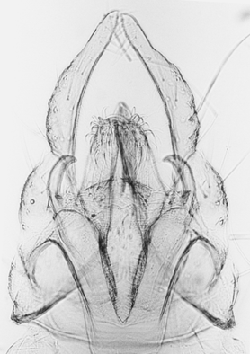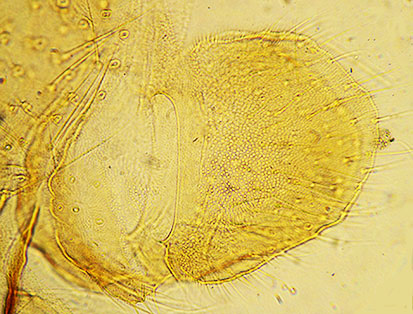C. 'jacksoni'C. 'jacksoni' Guryev et al. (2001); Martin (2011a)  Male terminalia of C. 'jacksoni' holotype. This is a typical C. oppositus-group hypopygium with E-type superior volsella. The case for considering this as a separate species is supported by a phylogenetic analysis based on allozyme and inversion frequencies (Martin 2011a). Adults: The adults are very similar to those of C. oppositus, but generally paler than those of C. pseudoppositus. As a result of the difficulty of separating them from the closely related species, adults can only be accurately identified if they come from the relatively small number of laboratory reared egg masses. See description of C. jacksoni holotype male Head: AR 2.64 (2.41-2.86). Frontal tubercles present, length about 28.1 (25-33) micron and about 3.1 (2.3-4.2) times longer than wide. About 27 (23-30) clypeal setae. Palpal proportions (microns): 68 : 64 : 200 : 218 : 338; P5/P4 1.55 (1.41-1.68); P5/P3 1.69 (1.48-2.08). Thorax generally green with yellow brown stripes and pruinose. Thoracic setae: 14.2 (12-17) acrostichals; dorsocentrals 12.7 (8-16); prealars 4.9 (4-6); supraalars 1.4 (1-2); scutellars in two rough rows, 4.0 (2-9) in anterior row, 12 (10-14) in posterior row (total 13-22). Wings with anterior veins hardly darker than posterior, crossvein slightly darkened. Legs yellowish green, unbanded. Leg lengths (microns) and proportions as follows:
Abdomen greenish with dark saddle spots on anterior segments, but whole of segments VI, VII and VIII dark; about 10.7 (9-12) setae in separate pale areas on tergite IX. Superior volsella of E(h) type of(Strenzke, 1959); gonostylus only moderately swollen and narrowing gently over posterior half; 5+1-6+1 setae at tip. IVo with simple setae and reaching about to end of anal point. Females: Colour generally as in male, abdomen with median saddle spots on segments II-V then covering most of the tergite; legs unmarked.Wings with anterior veins slightly darker, otherwise unmarked; length 3.92 (3.61-4.10) mm; width 1.14 (1.08-1.24) mm; VR 0.94-0.99; 3 SCf on brachiolum; 23.4 (20-26) setae in squamal fringe. Head: Cephalic tubules variable, athough this may be due to orientation, generally 16.8 (7-25) µm long and 1.2-2 times longer than wide. Antennal proportions (micron) with fraction of neck in brackets): 194 (0.31) : 132 (0.40) : 139 (0.45) : 121 (0.47) : 180. AR 0.33 (0.30-0.40); A5/A1 0.95 (0.89-1.00). Palp proportions (micron): 65 : 62 : 211 : 231 : 372. Clypeus about 1.54-2.00 times the diameter of the antennal pedicel; with about 47.9 (40-61) setae.Thorax generally yellow or green with brown vittae. Setae: Acrostichal - about 16 (at least 13-20); Dorsocentral extending anterior to the suture - 27.4 (23-34) with a group of 3-6 smaller setae in clear patches near the pronotum; prealar - 6.2 (5-8); supraalar - 1; Scutellar with setae in 2-3 rows, 16.4 (14-20) in posterior row and 13.5 (11-16) in one or two anterior rows. Leg lengths (micron) and proportions:
 Cercus and GsX (at left) of C. 'jacksoni' Cercus essentially rounded, wider dorsal/ventral than anterior/posterior, and with a slight basal ventral bulge. Types: Holotype male: Bellerive, Tasmania (42.83°S, 147.33°E) AT.9. Allotype female: Data as for holotype. Paratypes: 4 males, ? females, data as for Holotype, but various dates; also chromosome squashes with larval bodies mounted on same slide. Found: Tasmania - Bellerive; Bicheno; Flinders Island 1.3 km Whitemark, (including apparent hybrids with C. oppositus f. whitei). ; |
Modified: 8 March 2024
Access: Unrestricted
Copyright © 2005-2024, Jon Martin.